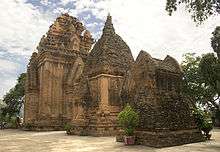Hinduism in Southeast Asia
|
Part of a series on
 |
Hinduism in Southeast Asia gave birth to the former Champa civilisation in southern parts of Central Vietnam, Funan in Cambodia, the Khmer Empire in Indochina, Langkasuka Kingdom, Gangga Negara and Old Kedah in the Malay Peninsula, the Sriwijayan kingdom on Sumatra, the Singosari kingdom and the Majapahit Empire based in Java, Bali, and parts of the Philippine archipelago. The civilisation of India influenced the languages, scripts, calendars, and artistic aspects of these peoples and nations.
History

Indian scholars wrote about the Dwipantara or Jawa Dwipa Hindu kingdom in Java and Sumatra around 200 BC. "Yawadvipa" is mentioned in India's earliest epic, the Ramayana. Sugriva, the chief of Rama's army dispatched his men to Yawadvipa, the island of Java, in search of Sita.[1] It was hence referred to in Indian by the Sanskrit name "yāvaka dvīpa" (dvīpa = island). Southeast Asia was frequented by traders from eastern India, particularly Kalinga, as well as from the kingdoms of South India.
The Indianised Tarumanagara kingdom was established in West Java around 400s, produced among the earliest inscriptions in Indonesian history. There was a marked Buddhist influence starting about 425 in the region. These Southeast Asian seafaring peoples engaged in extensive trade with India and China. Which attracted the attention of the Mongols, Chinese and Japanese, as well as Islamic traders, who reached the Aceh area of Sumatra in the 12th century.
Some scholars have pointed out that the legends of Ikshvaku and Sumati may have their origin in the Southeast-Asian myth of the birth of humanity from a bitter gourd. The legend of Sumati, the wife of King Sagar, tells that she produced offspring with the aid of a bitter gourd.[2]
Modern era
Today, vibrant Hindu communities remain in Malaysia, Singapore, Thailand, Medan city of Indonesia and the Philippines mainly due to the presence of Indians, such as Tamil people, who migrated from the Indian sub-continent to Southeast Asia in past centuries. One notably Southeast Asian aspect of Tamil Hinduism is the festival of Thaipusam, while other Hindu religious festivals such as Diwali are also well-observed by Hindus in the region. In Thailand and Cambodia, Thai and Khmer people practised Hindu rituals and traditions along with their Buddhist faith, and Hindu gods such as Brahma are still widely revered.
In Indonesia, it is not only people of Indian descent who practice Hinduism; Hinduism still survives as the major religion in Bali, where native Indonesians, the Balinese people, adheres to Agama Hindu Dharma, a variant of Hinduism derived from ancient Java-Bali Hindu traditions developed in the island for almost two millennia that often incorporates native spiritual elements. Other than the Balinese, a small enclave of Javanese Hindu minorities are also can be found in Java, such as around Tengger mountain ranges near Bromo and Semeru volcanoes, Karanganyar Regency in Central Java, and near Prambanan, Yogyakarta. Similarly, Hinduism is also found among the Cham minority in Southern Vietnam and Cambodia: just like the Javanese, the majority of them are Muslims but a minority are Hindu. In other parts of Indonesia, the term Hindu Dharma is often loosely used as umbrella category to identify native spiritual beliefs and indigenous religions such as Hindu Kaharingan professed by Dayak of Kalimantan.

The resurgence of Hinduism in Indonesia is occurring in all parts of the country. In the early 1970s, the Toraja people of Sulawesi were the first to be identified under the umbrella of 'Hinduism', followed by the Karo Batak of Sumatra in 1977 and the Ngaju Dayak of Kalimantan in 1980. In an unpublished report in 1999, the National Indonesian Bureau of Statistics admitted that around 100,00 she had officially converted or 'reconverted' from Islam to Hinduism over the previous two decades.[4] The Ministry of Religious Affairs, as of 2007 estimates there to be at least 10 million Hindus in Indonesia[5]
The growth of Hinduism has been driven also by the famous Javanese prophesies of Sabdapalon and Jayabaya.
Many recent converts to Hinduism had been members of the families of Sukarno's PNI, and now support Megawati Sukarnoputri. This return to the 'religion of Majapahit' (Hinduism) is a matter of nationalist pride.
The new Hindu communities in Java tend to be concentrated around recently built temples (pura) or around archaeological temple sites (candi) which are being reclaimed as places of Hindu worship. An important new Hindu temple in eastern Java is Pura Mandaragiri Sumeru Agung, located on the slope of Mt. Semeru, Java's highest mountain. Mass conversions have also occurred in the region around Pura Agung Blambangan, another new temple, built on a site with minor archaeological remnants attributed to the kingdom of Blambangan, the last Hindu polity on Java, and Pura Loka Moksa Jayabaya (in the village of Menang near Kediri), where the Hindu king and prophet Jayabaya is said to have achieved spiritual liberation (moksa). Another site is the new Pura Pucak Raung in East Java, which is mentioned in Balinese literature as the place from where Maharishi Markandeya took Hinduism to Bali in the 5th century.
An example of resurgence around major archaeological remains of ancient Hindu temple sites was observed in Trowulan near Mojokerto, the capital of the legendary Hindu empire Majapahit. A local Hindu movement is struggling to gain control of a newly excavated temple building which they wish to see restored as a site of active Hindu worship. The temple is to be dedicated to Gajah Mada, the man attributed with transforming the small Hindu kingdom of Majapahit into an empire. Although there has been a more pronounced history of resistance to Islamization in East Java, Hindu communities are also expanding in Central Java near the ancient Hindu monuments of Prambanan.
The current estimates of Hinduism in Indonesia range from 4 to 8 percent
Regions
Burma
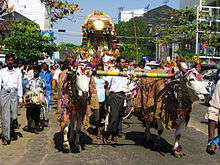
Hinduism in Burma is practised by about 840,000 people.[6] Because a reliable census has not been taken in Burma since colonial times, estimates are approximate. Most Hindus in Myanmar are Burmese Indians.
Cambodia
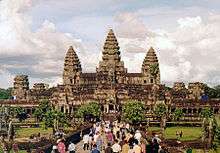
Cambodia was first influenced by Hinduism during the beginning of the Kingdom of Funan. Hinduism was one of the Khmer Empire's official religions. Cambodia is the home of the holy temple of Angkor Wat, the largest Hindu temple in the world.
Thailand
Although only a minority of Thai identify as Hindu today, many Hindu gods such as Indra and Brahma are still worshiped today. Ancient Hindu rituals are still practiced which include customs such as marriage ceremonies. One of the well known aspects of Hindu culture include the Giant Swing.
Indonesia
Today in Indonesia, Hinduism is practised by 3% of the total population, they constitute 92.29% of the population of Bali and 15.75% of the population of Central Kalimantan, as of the 2000 census. However, between the 4th century to 15th century, Hinduism and Buddhism was adhered by the majority of the population, along with native indigenous animism and dynamism beliefs that venerated natural and ancestral spirits. By 15th to 16th-century Islam had supplanted Hinduism and Buddhism as the majority religion in Indonesian archipelago. The influence of Hinduism has profoundly left its marks on the culture of Bali, Java and Sumatra. Bali has become the last remnant of once Hindu dominated region.
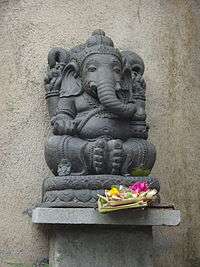
Hindu influences reached the Indonesian Archipelago as early as first century. In 4th-century, the kingdom of Kutai in East Kalimantan, Tarumanagara in West Java, and Holing (Kalingga) in Central Java, were among the early Hindu states established in the region. Several notable ancient Indonesian Hindu kingdoms are Mdang i Bhumi Mataram, famous for the construction of the majestic 9th-century Trimurti Prambanan temple, followed by Kediri, singosari, and reached the peak of its influence in the 14th-century Majapahit, the last and largest among Hindu-Buddhist Javanese empires.
The Hindu civilisations has left its marks in Indonesian culture. The epics Mahabharata and Ramayana, became enduring traditions among Indonesian artforms, expressed in wayang shadow puppet and dance performances. Many Indonesian names are Sanskrit-based and the plane flag carrier are named Garuda Airline.
Today, the Indonesian government has recognised Hinduism as one of the country's six officially sanctioned religions, along with Islam, Protestantism, Catholicism, Buddhism and Confucianism.[7]
Laos
Laos used to be part of Khmer Empire. The Wat Phou is one of the last influences of that period. The Laotian adaptation of the Ramayana is called Phra Lak Phra Lam.
Malaysia
Hinduism is the fourth largest religion in Malaysia. About 1.78 million Malaysian residents (6.3% of the total population) are Hindus, according to 2010 Census of Malaysia.[8]
Most Malaysian Hindus are settled in western parts of Peninsular Malaysia. Indian Hindus and Buddhists began arriving in Malaysia during ancient and medieval era. A large number of Hindus from South India were brought to Malaysia by British colonial empire during the 19th and 20th century, as indentured labourers to work on coffee and sugarcane plantations and tin mining; later they were deployed in large numbers, along with Chinese Buddhists, on rubber plantations. The British kangani system of recruitment, designed to reduce labour turnover and enhance labour stability, encouraged Hindu workers to recruit friends and family from India to work in British operations in Malaysia. The kangani system brought numerous Tamil Hindus into Malaysia by early 1900s.[9] By 1950s, about 12.8% of Malaysian population professed to be a Hindu.
After Malaysia gained its independence from British colonial empire in 1957, it declared its official state religion as Islam, and adopted a discriminatory constitution as well as the Sedition Act of 1971 which limited public debate on Malaysia's treatment of religion, language and citizenship policies.[10][11][12] In recent decades, there have been increasing reports of religious persecution of Hindus, along with other minority religions, by various state governments of Malaysia and its Sharia courts.[10][13] Hindu temples built on private property, and built long before Malaysian independence, have been demolished by Malaysian government officials in recent years.[14] Since the 1970s, there has been large scale emigration of Hindus (along with Buddhists and Christians) from Malaysia.[15][16][17]
Malaysian Hindus celebrate Deepavali (festival of lights), Thaipusam (Lord Murugan festival), Pongal (harvest festival) and Navaratri (Durga festival).
The Philippines

Before the arrival of an Arab trader to Sulu Island in 1450 and Ferdinand Magellan, who sailed in behalf of Spain in 1521, the chiefs of many Philippine islands were called Rajas, and the script was derived from Brahmi. Karma, a Hindu concept is understood as part of the traditional view of the universe by many Philippine peoples, and have counterparts such as kalma in the Pampangan language, and Gabâ in Visayan languages. The vocabulary in all Philippine languages reflect strong Hindu influences.
In the archipelago that was to become the Philippines, the statues of the Hindu gods were hidden to prevent their destruction by a religion which destroyed all cult images. One statue, a "Golden Tara", a 4-pound gold statue of a Hindu-Malayan goddess, was found in Mindanao in 1917. The statue, denoted the Agusan Image, is now in the Field Museum of Natural History, Chicago. The image is that of a Hindu-Malayan female deity, seated cross-legged. It is made of "twenty-one carat gold and weighs nearly four pounds." It has a richly ornamented headdress and many ornaments in the arms and other parts of the body. Scholars date it to the late 13th or early 14th century. It was made by local artists, perhaps copying from an imported Javanese model. The gold that was used was from this area, since Javanese miners were known to have been engaged in gold mining in Butuan at this time.
The existence of these gold mines, this artefact and the presence of "foreigners" proves the existence of some foreign trade, gold as element in the barter economy, and of cultural and social contact between the natives and "foreigners." As previously stated, this statue is not in The Philippines. Louise Adriana Wood (whose husband, Leonard Wood, was military-governor of the Moro Province in 1903-1906 and governor general in 1921-1927) raised funds for its purchase by the Chicago Museum of Natural History. It is now on display in that museum's Gold Room.
According to Prof. Beyer, considered the "Father of Philippine Anthropology and Archaeology", a woman in 1917 found it on the left bank of the Wawa River near Esperanza, Agusan, projecting from the silt in a ravine after a storm and flood. From her hands it passed into those of Bias Baklagon, a local government official. Shortly after, ownership passed to the Agusan Coconut Company, to whom Baklagon owed a considerable debt. Mrs. Wood bought it from the coconut company.
Another gold artefact of Garuda, the phoenix who is the mount of Vishnu, was found in Palawan.
There are smaller number of followers of Hinduism today at 1% of the Philippine population.[18]
Today, there is a "Hindu Temple" (attended mostly by Sindhīs) on Mahatma Gandhi Street and a "Khalsa Diwan Indian Sikh Temple" (attended mostly by Sikhs) on United Nations Avenue. Both are in Manila city's Paco-Pandacan area, the traditional Indian enclave, and are about 15 minutes walk away from each other.[19] As per estimate there are 22 gurudwāras all over the Philippines today, although most of the adherents are Indians, Sri Lankans and Nepalese. There are various Hare Krishna groups in the country that are gaining in popularity.
The spread of Hinduism was deterred by the spread of Christianity by the Spaniards and the spread of Islām by Malay and Javanese missionaries before the Spaniards.
Singapore
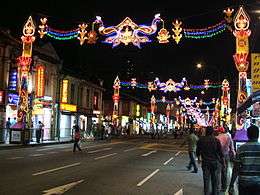
The introduction of Hinduism into Singapore dates back to the early 10th century, during the Chola period. Immigrants from southern India, mostly Tamils, arrived as labourers for the British East India Company, bringing with them their religion and culture. Their arrival saw the building of Dravidian temples throughout the island, and the beginnings of a vibrant Hindu culture. The first temple, Sri Mariamman Temple in Singapore's Chinatown. There are currently about thirty main temples in Singapore, dedicated to various gods and goddesses from the Hindu pantheon. Today, two government bodies deal with all Hindu affairs: The Hindu Endowments Board and The Hindu Advisory Board.
Hindus are a minority in Singapore, comprising about 5.1% of its citizens and permanent residents in 2010. Among 15 years or older population, there were about 158,000 Hindus; 37% of all Hindus in Singapore speak Tamil at home, another 42% speak English.[20] Deepavali is a major Hindu festival and a public holiday observed in Singapore.[21]
Thailand


A number of Hindus remain in Thailand. They are mostly located in the cities. In the past, the nation came under the influence of the Khmer Empire, which had strong Hindu roots. The epic, Ramakien, is based on the Ramayana. The Thai city, Ayutthaya near Bangkok, is named after Ayodhya, the birthplace of Rama. Numerous rituals derived from Brahmanism are preserved in rituals, such as use of holy strings and pouring of water from conch shells. Furthermore, Hindu deities are worshipped by many Thais alongside Buddhism, such as Brahma at the famous Erawan Shrine, and statues of Ganesh, Indra, and Shiva, as well as numerous symbols relating to Hindu deities are found, e.g., Garuda, a symbol of the monarchy. Reliefs in temple walls, such as the 12th-century Prasat Sikhoraphum near Surin (Thailand), show a dancing Shiva, with smaller images of Parvati, Vishnu, Brahma and Ganesh.[22]
An annual Giant Swing ceremony known as Triyampavai-Tripavai was held in major cities of Thailand until 1935, when it was abolished for safety reasons.[23] The name of the ceremony was derived from the names of two Tamil language Hindu chants: Thiruvempavai and Thiruppavai. It is known that Tamil verses from Thiruvempavai — poet pratu sivalai ("opening the portals of Shiva's home") — were recited at this ceremony, as well as the coronation ceremony of the Thai king.[24] According to T.P. Meenakshisundaram, the name of the festival indicates that Thiruppavai might have been recited as well.[25] The swinging ceremony depicted a legend about how the god created the world. Outside shops, particularly in towns and rural areas, statues of Nang Kwak as the deity of wealth, fortune and prosperity (version of Lakshmi) are found.[26][27]
The élite, and the royal household, often employ Brahmins to mark funerals and state ceremonies such as the Royal Ploughing Ceremony to ensure a good harvest. The importance of Hinduism cannot be denied, even though much of the rituals has been combined with Buddhism.[28]
According to the Thai Census of 2005, there are 52,631 Hindus living in Thailand, making up just 0.09% of the total population.[29]
Vietnam
_(4395499696).jpg)
The Champa civilisation was located in the more southern part of what is today Central Vietnam, and was a highly Indianized Tamil Hindu Kingdom, practising a form of Tamil Shaivite Hinduism brought by sea from India. Mỹ Sơn, a Hindu temple complex built by the Cham people is still standing albeit in ruins in Quảng Nam Province, in Vietnam. Since the 15th century under the growing Vietnamese kingdom from the north, Champa was conquered and reduced as a polity. The Chams were subsequently absorbed by the Vietnamese and today are recognised one of the many ethnic minorities of Vietnam.
The Balamon Hindu Cham form a majority of the Cham population in Vietnam while most of the remainder are followers of Islam. The term Balamon is considered to have been derived from Brahmin,[30] however another study suggests that 70% are considered to descend from the Nagavamshi Kshatriya caste[31] (pronounced in Cham(?) as "Satrias"), and claim to be the descendants of the Champa Empire.[32] In any case a sizeable proportion of the Balamon Hindu Cham are considered Brahmins.
Hindu temples known as Bimong in the Cham language and the priests Halau Tamunay Ahier.
The exact number of Tamil Hindus in Vietnam are not published in Government census, but there are estimated to be at least 50,000 Balamon Hindus, with another 4,000 Hindus living in Ho Chi Minh City; most of whom are of Indian (Tamil) or of mixed Indian-Vietnamese descent. The Mariamman Temple is one of the most notable Tamil Hindu temples in Ho Chi Minh City. Ninh Thuan and Binh Thuan Provinces are where most of the Cham ethnic group (~65%) in Vietnam reside according to the last population census. Cham Balamon (Hindu Cham) in Ninh Thuan numbered 32,000 in 2002 inhabiting 15 of 22 Cham villages.[30] If this population composition is typical for the Cham population of Vietnam as a whole then approximately 60% of Chams in Vietnam are Hindu.
See also
References
- ↑ History of Ancient India Kapur, Kamlesh
- ↑ Elst, Koenraad (1999). Update on the Aryan Invasion Debate. Aditya Prakashan. ISBN 81-86471-77-4.; Sergent, Bernard: Genèse de l'Inde, 1997.
- ↑ Beryl De Zoete, Dance and Drama in Bali, ISBN 978-9625938806
- ↑ http://www.swaveda.com/articles.php?action=show&id=49
- ↑ http://www.state.gov/g/drl/rls/irf/2007/90137.htm
- ↑ Table: Religious Composition by Country, in Numbers Pew Research Center (December 2012)
- ↑ Hosen, N (8 September 2005). "Religion and the Indonesian Constitution: A Recent Debate" (PDF). Journal of Southeast Asian Studies. Cambridge University Press. 36 (03): 419. doi:10.1017/S0022463405000238. Archived from the original (PDF) on 28 August 2006. Retrieved 26 October 2006.
- ↑ 2010 Population and Housing Census of Malaysia (Census 2010) Department of Statistics Malaysia, Official Portal (2012)
- ↑ Sandhu (2010), Indians in Malaya: Some Aspects of Their Immigration and Settlement (1786-1957), Cambridge University Press, ISBN 978-0521148139, pp. 89-102
- 1 2 2011 Report on International Religious Freedom - Malaysia U.S. State Department (2012)
- ↑ Gill & Gopal, Understanding Indian Religious Practice in Malaysia, J Soc Sci, 25(1-2-3): 135-146 (2010)
- ↑ Raymond Lee, Patterns of Religious Tension in Malaysia, Asian Survey, Vol. 28, No. 4 (Apr. 1988), pp. 400-418
- ↑ Religious Freedom Report 2013 - Malaysia U.S. State Department (2014)
- ↑ Religious Freedom Report 2012 - Malaysia U.S. State Department (2013)
- ↑ Malaysian Indian Community: Victim of ‘Bumiputera’ Policy ORF Issue Report (2008)
- ↑ Amarjit Kaur, Indian migrant workers in Malaysia – part 1 Australian National University
- ↑ Amarjit Kaur, Indian migrant workers in Malaysia – part 2 Australian National University
- ↑ http://www.globalreligiousfutures.org/countries/philippines/religious_demography#/?affiliations_religion_id=0&affiliations_year=2010
- ↑ In the late 1970s and early 1980s, the ISKCON temple was right beside the Hindu Temple.
- ↑ Census of population 2010 Singapore Department of Statistics (2011)
- ↑ Public Holidays Ministry of Manpower, Singapore
- ↑ Sikhoraphum, Thailand, Arts & Archaeology Journal
- ↑ M. E. Manickavasagom Pillai (1986). Dravidian Influence in Thai Culture. Tamil University. p. 69.
- ↑ Upendra Thakur (1986). Some Aspects of Asian History and Culture. Abhinav. pp. 27–28. ISBN 978-81-7017-207-9.
- ↑ Norman Cutler (1979). Consider Our Vow: Translation of Tiruppāvai and Tiruvempāvai Into English. Muttu Patippakam. p. 13.
- ↑ Ara Wilson (2008), The Sacred Geography of Bangkok’s Markets, International Journal of Urban and Regional Research, Volume 32.3, September 2008, page 635
- ↑ Jonathan Lee, Fumitaka Matsuoka, Edmond Yee and Ronald Nakasone (2015), Asian American Religious Cultures, ABC, ISBN 978-1598843309, page 892
- ↑ Hinduism Today | Thailand | July/August/September, 2003
- ↑ http://popcensus.nso.go.th/show_table.php?t=t5&yr=2543&a=1
- 1 2 Champa and the archaeology of Mỹ Sơn (Vietnam) By Andrew Hardy, Mauro Cucarzi, Patrizia Zolese p.105
- ↑ India's interaction with Southeast Asia, Volume 1, Part 3 By Govind Chandra Pande, Project of History of Indian Science, Philosophy, and Culture, Centre for Studies in Civilizations (Delhi, India) p.231,252
- ↑ International Religious Freedom Report 2004, U.S. Department of State.
External links
- Map of Khmer Empire art reveals ancient urban sprawl
- Thailand Hinduism - A report on Hinduism in Thailand
- Overview of Hindu influence in Thailand
- Hindu-Buddhist Java and Southeast Asia
- Hindu-Kaharingan Tiwah ceremony in Borneo
- Hindu revival in Java
- A tribute to hinduism
- Hindu influence in Southeast Asia
- Siddha Yoga Tradition in Malaysia
- Heritage bid unites border rivals

